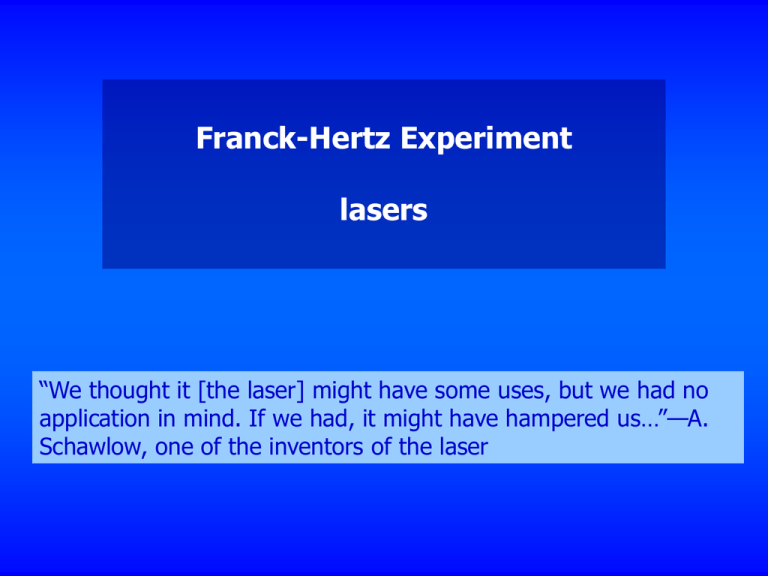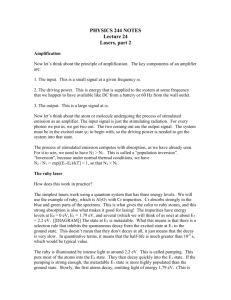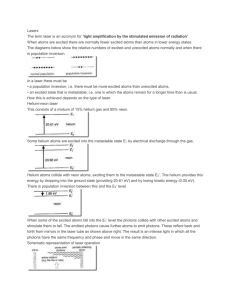The Franck-Hertz* Experiment
advertisement

Franck-Hertz Experiment lasers “We thought it [the laser] might have some uses, but we had no application in mind. If we had, it might have hampered us…”—A. Schawlow, one of the inventors of the laser The Franck-Hertz* Experiment (1914) This famous experiment confirmed the existence of Bohr’s atomic energy levels. Accelerated electrons colliding with atoms give up energy to atomic electrons, provided their energy is sufficient to promote an atomic electron from one energy level to a higher one. *1925 Nobel Prize for Franck and Hertz. And no, not the Hertz of Hz fame. Gustav Hertz, not Heinrich Hertz. Hyperphysics shows the experimental setup (previous slide) and this actual data. (Note: I purchased a hyperphysics “license” to use this material in my teaching.) Here is an interactive Franck-Hertz experiment. Things I might ask on a test: what did this experiment demonstrate? Interpret the dips in the current versus voltage curve. 4.9 Lasers Background information and terms. Absorption and emission (induced) absorption -- we have talked about this already; a photon raises an atom to an excited state (spontaneous) emission -- we have talked about this already; an atom in an excited state drops back to the ground state via emission of a photon (induced) emission -- a photon of the energy required to produce induced absorption can induce an atom to drop from the excited state back to the ground state -- the probability of this occurring is same as the probability of absorption occurring huh? “Induced emission” is also called stimulated emission. For atoms in a radiation field, quantum theory (Einstein, 1916) shows that the probability of a ground state atom absorbing a photon is equal to the probability of an excited state atom emitting the same photon. Those of you who have pushed children (or brothers, sisters, etc.) on a swing have experienced this. You can give the swinger energy by pushing in phase with the swings. Or you can remove energy from the swinger by pushing out of phase with the swings. Those of you who have sunk your fleet of toy ships in the bathtub by sloshing back and forth to make ever-increasing waves have done the same. When mom hollers, you absorb the wave energy by sloshing out of phase. More terms: lifetime Here’s a schematic energy-level diagram of an excited state. Most excited states have very short lifetimes. E1 > E0 excited state E0 ground state electron metastable state -- a relatively long-lifetime excited state population inversion -- a majority of the atoms in a system are in excited states If a majority of atoms are in excited states, then emission rather than absorption is more probable. optical pumping -- using photons to create a population inversion Laser: light amplification by stimulated emission of radiation. Required for a laser: metastable states in the lasing material an optical cavity method of pumping metastable states to achieve a population inversion We’ll see the significance of all these fine-sounding requirements in a bit. Any Nobel Prizes? Townes, Basov, and Prokhorov, 1964. Also Bloembergen and Schawlow, 1981; Chu, Tannoudji, and Phillips, 1997; and Cornell, Ketterle, and Wieman, 2001. Maybe if you want a Nobel prize, do something with lasers! On the other hand, Gordon Gould invented the “laser” and built the first one; it took 20 years for him to win any recognition for it. Properties of lasers Laser light is: coherent; i.e. all waves are exactly in phase (nearly) monochromatic controlled by the size of the aperture through which it leaves; the divergence can be made extremely small very intense (1030 K, whatever a temperature that high really means) More toys! (Illustrating some of the above properties.) Let’s make a laser. Begin by finding an atom with a metastable state. Atomic spectroscopists have measured zillions of atomic states, so we can surely find one. Start to make a population inversion, by exciting an electron to the metastable state. Remember, this state lives a long time. Now excite another electron to the metastable state. E1 > E0 E0 metastable state ground state Oh dang! I forgot that the incoming photon is just as likely to induce emission as it is to induce absorption.* (Another toy here.) This won’t work! What to do? *This picture does not reflect reality. I really should draw many different atoms, showing an electron in each. Also, the 2nd photon could excite a 2nd electron. You “can’t”* make a two-level optically-pumped laser. Key bit of knowledge we won’t introduce until chapter 6: all transitions have probabilities of occurring. Some transitions have greater probabilities than others. The intellectual leap: if I can find an atom with an excited state and a nearby metastable state… and if the transition from the excited state to the metastable state is far more likely than the transition from the excited state to the ground state… then I can make a three-level laser. *Not a good idea to say “can’t.” See here. A three-level laser; the setup: excited state E2 E1 E0 metastable state ground state A three-level laser; how it works: Excited the transition to the metastable state could be radiationless Metastable Ground Put an electron in the metastable state. (using collisions or photons) More, more, more, more! Notice: red photons come out not in phase. Wasted! But population inversion has been created. Now we have all these electrons in a metastable state. What next? Excited Metastable It’s 3:05 on a Friday. My lecture is running way over time and shows no sign of stopping. You are all sitting here with your packed backpacks in hand, anxious to go. Ground One of you can’t take it any more and walks noisily out. Boom! You all go. Students have been simulating lasers for decades! You can wait and let the final step happen naturally, or you can stimulate it by sending in a photon having an energy equal to the energy difference between metastable and ground state. Excited Metastable Ground The photons come virtually out all at once, and in phase! I did “cheat” on the last slide. I made the electrons drop to the ground state all at the same instant, and made the photons come out all in the same direction. They don’t. See here. Remember the requirements for a laser? metastable states in the lasing material--check method of pumping metastable states to achieve a population inversion--check an optical cavity—missing from this presentation Howstuffworks shows what the optical cavity does. Here’s a toy showing the effect. A ruby* laser is an example of a three-level laser as described above. excited state 2.25 eV optical pumping 550 nm ground state radiationless transition metastable state laser transition 694.3 nm 0 eV Know the meaning of all the terms in the figure above! Be able to calculate the energies and wavelengths for all transitions! *What’s a ruby? 1.79 eV For a three-level laser to work, more than half the atoms must be in the metastable state. It would be “nice” to get lasing without having to pump so “hard.” A four-state laser does just that. On the next slide is a schematic of a He-Ne laser. Sorry, no fancy animations on this one. He-Ne laser (energy levels not drawn to scale): (2) excited state 20.61 eV (3) (4) metastable state 20.66 eV excited state 18.70 eV (1) electron impact (2) collisions (of what?) (1) (5) (3) laser transition 632.8 nm (4) spontaneous emission ground state helium neon (5) radiationless transition Be able to explain terms and calculate energies and wavelengths! Applications of lasers. “It’s a solution looking for a problem!” The National Ignition Facility NIF is a 192-beam 1.8 MJ laser for creating conditions of extreme temperatures and pressures in the laboratory. The purpose: fusion! The 192 lasers will be focused on a target about the size (if I remember correctly) of the tip of a ballpoint pen.* Fusing about 10 targets* per second would produce a net energy output comparable to a 1000 MW power plant. Not everybody thinks this is a good idea! *Rough figures vaguely remembered from a lecture several years ago. Applets and other handy links, mostly already used above: http://jersey.uoregon.edu/vlab/elements/Elements.html http://dbhs.wvusd.k12.ca.us/Electrons/Spectrum-History.html http://www.colorado.edu/physics/2000/quantumzone/lines2.html http://www.colorado.edu/physics/2000/quantumzone/bohr2.html http://www.howstuffworks.com/laser2.htm http://www.repairfaq.org/sam/lasersam.htm http://www.llnl.gov/nif/construction/october2001.html http://www.colorado.edu/physics/2000/lasers/lasers2.html







